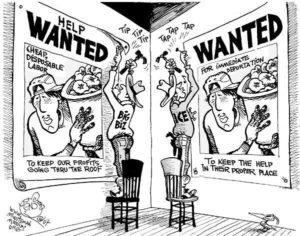 This image depicts the exploitation of immigrants and refugees in terms of extorting them for money and labor yet persecuting them simultaneously.
This image depicts the exploitation of immigrants and refugees in terms of extorting them for money and labor yet persecuting them simultaneously.
Author: imaxey
Mistrust, Anger, and Hostility in Refugees, Asylum Seekers, and Immigrants: A Systematic Review
This article analyzes Western societies and their growing xenophobia, especially towards immigrants, refugees, and asylum-seekers. Though Western society has already been known to displace and fear minorities and developing countries, in our postmodern society western societies are starting to witness major demographic changes because of the human displacement that they as a whole continue to fuel through taking actions that are not only ineffective but harmful. These actions include closing borders, enacting laws that place immigrants and refugees in detention centers, and other unjust practices.
The terrorist attacks on September 11 in 2001 done by terrorist group Al-Quaeda and the multiple, expensive wars that have followed as a result have only increased Western societies’ feelings of hostility, anger, and mistrust toward refugees, asylum seekers, and immigrants, especially those from Middle Eastern countries. The constant mistrust of Western society has not only scared North America, where the attacks happened, but other countries as well such as Britain, Russia, and other Western countries that have increased border control. The stigma surrounding terrorism has been married to immigration and foreign insertion.
This article is a review of the overall system driven by the intent to gather additional sources and information to prove the presence of society’s hostile attitudes and feelings of anger and mistrust toward these refugees, as well as show that they may have a negative impact on their general well-being. It also aimed to identify whether society’s discrimination and negative feelings toward this population influence the refugees’ willingness to seek support from services
provided by the host society and, simultaneously, to trust the helping professionals who provide the services.
Article Summary 2
This article capitalizes on Trump’s statement that America is “closed” and “full,” unable to accept illegal immigrants any longer. The statement comes after Trump threatened to close the U.S.-Mexican border completely. In response, Mexico took legal action to close border crossings. The article continues to blame Democrats, often referring to them as “Dems,” and attributes the influx of immigrants to Dems “gaming the system.” The article fails, however, to provide specific examples of these claims. The article also continuously quotes Trump and his statements, saying, “They could stop them at the southern border, their southern border. And you look at what’s happening now. They pulled in fifteen hundred, one thousand five hundred yesterday they brought them back. They pulled in over a thousand the day before. Over a thousand the day before that today I haven’t gotten the number but I mean it’s a lot.”
While the article goes has several of these types of quotes, it fails to provide substantiated support behind Trump’s claims. Rather than providing any statistical evidence as to how America is “full,” the article claims that Trump’s actions are motivated solely by his desire for the safety of the American people, that illegal immigrants are somehow a danger to our way of life. However, Trump does not say that there is any stigma of fear behind his actions, but does say that it is due simply to the lack of space in detention centers. He gives no real reason for why immigrants are not welcome into America except for that detention centers are full.
Article Summary – Border Crackdowns Feed a Self-Reinforcing Cycle of Fear and Backlash
The article I read was from The New York Times, published April 2nd, 2019. The first half of the article discusses the all-time low of Net migration at the southern border of the United States. The article then attributes this low to the fact that the Trump administration is not only pushing policies that deflect refugees but treats them as invaders. Detention centers have been filling as a result of this, many without the most basic medical needs and living conditions necessary to sustain countless families. The issue is not that the amount of arrivals has gone down, but simply where these policies on “border control” are displacing them.
This is a pattern in countless Western democracies, according to the article, which states, “anti-immigration sentiment is driving demand for harsh policies that may not only fail to reduce arrivals, but to also make the problem look even more uncontrolled and overwhelming” (Fisher & Taub, 2019).
The article then discusses the intrinsic homogenous needs of white people, and their instinct to fear difference and embrace familiarity. The effect of this is the vicious cycle that sends immigrants and refugees to detention centers and other places where they are subjected to mistreatment of all sorts, all for the sake of control being under the guise of “protection.” It discusses the cycle taking place 30 years ago when a border was put up along San Ysidro crossing. This led to an influx of immigrants migrating and crossing Interstate 5, where many families were hit by cars. This led to several yellow traffic signs being put up, depicting a dashing family as “immigrant crossing”. This sparked a nationwide backlash against unauthorized immigration.
The second half of the article discusses the situation in Europe, where they have tightened their borders. This forced many refugees to travel by boat, and many sank. The article then says the fear of allowing refugees in is a psychological movement and natural human defense mechanism.
Provocation Group 3
In Chapter 31, Ifemelu cheats on Curt because she is overwhelmed by the pressure of being in an interracial relationship. After weeks of asking him to take her back, she finally accepts reality. Years later at a party, she talks with another woman about her interracial relationship and says that race was never an issue, which Ifemelu finds difficult to believe. She thought about her relationship with Curt and how there were certain disparities he clearly could not see, as he was living with the “colorblind” mindset. Her friend, Wambui, suggests to start a blog, and she considers and creates it a few weeks after she breaks up with Curt. The chapter ends with a blog post about how a black woman’s hair is a metaphor for America. She says she is a groupie for Michelle Obama and would like to see once how she or Beyonce would look with their natural hair.
In the book, that portion of the chapter reads, “Imagine if Michelle Obama got tired of all the heat and decided to go natural and appeared on TV with lots of woolly hair, or tight spirally curls…She would totally rock but poor Obama would certainly lose the independent vote, even the undecided Democrat vote.” (Adichie 368).
My question is why do you think society associates something natural for black people with inadequacy?
Sources
“Chapter 31.” Americanah, by Chimamanda Ngozi Adichie, Anchor Books, A Division of Random House LLC, New York, 2013, pp. 368.
Carlos Hernandez Visit
Carlos Hernandez’s visit was well-anticipated after reading his poetry prior to the visit. The difference was definitely seen and heard when he read the poetry aloud to the class, with a distinct intonation in each word of his poems. It was as though we were with him in the time that he was writing this. He took us on a Spanglish journey through his poetry and showed the power that diversity in languages has when writing poetry, or writing in general. It was definitely a new experience for me, and relatable at the same time as I myself am bilingual as well. While he discussed the different aspects of poetry and his inspirations, he also touched base upon the online field of publishing poetry and encouraging us to start as early as now to get published. He gave many links and websites that would help us and discussed the different aspects of lining and spacing online. While it costs much in print, it costs next to nothing online because there’s no ink or additional pages to pay for. However, he pointed out that the audience is slightly different, as an online audience’s attention span is much shorter and less dedicated to reading. Luckily his poetry is as interesting as it is lengthy, and I look forward to reading more of his work.
Grant Post
My idea is to work with the LIRS to have an event where refugees and those who have helped in the LIRS share their stories publicly in a TED-Talk style format and have it featured on the news. The LIRS already offers on their website an opportunity to “share your story,” and it inspires people to donate. Giving a much more public platform and bringing the stories to donors rather than trying to get the donors to visit is another option, and brings a life-like quality to the stories. It makes it personal as opposed to trying to convey feelings through a screen.
Entrepreneurship and the diversity of business
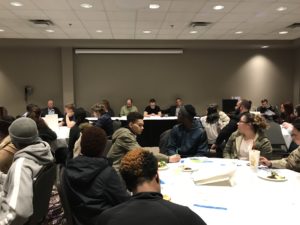
The business panel was incredibly inspiring and informative. While entrepreneurship is often viewed as a wealthy practice, there’s a lot more risk that goes into the occupation than meets the eye. The entrepreneurs present on the panel were John Dinkel of Dinkel Business Development, our very own Chris Daley of Whirlaway PR, Andrew Murphy of Flying Frog Publishing, Elizabeth Trimm of Enterprise Rent-A-Car, Andy Brown of Eat Pizza, and Garrett Pfiefer of Maryland Brand Management. All of them provided their own informative and sometimes humorous stories when answering questions pertaining to their experiences. What I found most interesting was that Andy Brown of Eat Pizza had graduated from Stevenson in 2012, and has been working in Virginia with three businesses ever since. He talked about how he began as a DJ, and never would have thought he would be signing with the Greene Turtle his recipe for pizzas. That was a very inspiring story for me to hear, among others. When talking about how business and personal life mix, Elizabeth Trimm talked about how she was a single mother, so she didn’t have much of a choice to do otherwise but to mix the two. That was another inspiring story because not only did she pursue her passion, but was able to care for her family.
The panel relates to the information in the digital publishing course in terms of how a business presents themselves. In digital publishing, we focus on the context and genres of companies, who they are trying to reach and who the companies are. That’s essentially what good businesses do, analyzing themselves as well as others, and finding ways to present themselves in the best and accurate light possible. For example, Garrett Pfiefer’s company is located in Towson. He explained to me after the panel had ended that he is currently managing 14 social media accounts for his company, and is in need of interns. I said that as a Business Communication major I would be happy to direct him to a potential social media specialist, but turned down the internship offer as I have yet to take more classes to help hone my skills to be capable of work at that caliber. This class is included among those that would prepare me for that career choice. While I am not entirely sure what career I will choose to pursue after graduation, I may consider Public Relations, which is why it is fortunate that Chris Daley is not only an owner of his own PR firm but a professor at Stevenson. If I hadn’t gone to the panel, I would have not been able to discuss with him the details of his business.
How the LIRS uses Rhetoric to Induce Change as a Nonprofit with their Website
The Lutheran Immigration and Refugee Service (LIRS) is a nonprofit organization dedicated to providing service for immigrants and refugees facing persecution. Motivated by their faith, they have developed service programs, organizations, and influenced public policy (Lutheran Immigration and Refugee Service, 2019); all of which can be found on their website, www.lirs.org. While the organization’s goal is to serve, the website’s authors communicate using rhetoric to reach their intended audiences, inform them of the organization’s purpose, the genre of the organization, and the context in terms of how it is relevant today. Using rhetoric successfully will allow the LIRS to effectively induce change from their website.
The audience LIRS is trying to reach varies, as it provides multiple opportunities to engage with the organization for different types of people. Donors and volunteers are the primary audiences of the website. This is shown through the buttons on the navigation bar, as the last but brightest button is “DONATE.”

The color and style the button is presented with deviates from the format of the navigation bar. Along the navigation bar, the buttons link to different pages on the website that give insight as to what the organization’s mission and purpose is, how someone can help, donate, and “take action” (Lutheran Immigration and Refugee Service, 2019). The secondary audiences are the refugees and immigrants that have been helped or are seeking help. The reason they are secondary and not primary is because there are more opportunities provided on the website to donate and volunteer than there are to help the refugees and immigrants directly from online. This could be because LIRS assumes that most do not have access to the internet. When the home page is opened, there is a large graphic that reads “Read the stories” and “Share your story,” and provides inspirational accounts of refugee experiences from those they are aiding.
The overall intention of trying to reach these audiences is to persuade viewers to give to their organization whether it be in the form of time and energy, personal accounts, or money. An additional purpose is to inform the public of the power of their faith, as they are a religious-affiliated organization. A portion of the website is dedicated to religious writing, in the form of downloadable prayers or readable sessions about the Lutheran faith. While the site does not directly educate on what the religion is by definition, it provides perspectives and online sessions to read religious texts written by the authors of the website.
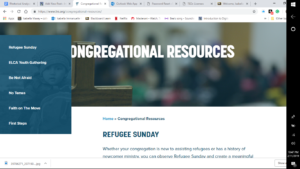
Broadly defined, the LIRS website is a nonprofit service organization. Beneath a more specific lens, it is a religious-affiliated organization that focuses on aiding immigrants, refugees, and other asylum-seekers. Key features that tell the audience it belongs to the nonprofit genre of websites are its spatial, linguistic, and visual modes. This multimodal text uses a spatial organization with a one-column style of text and linguistics in English and the option to read in Spanish.
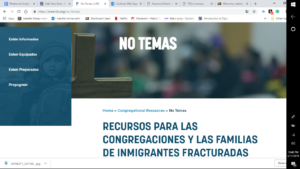
It is not meant to be complicated or require deep analysis to find its purpose and resources, and is made easy-to-read to pertain to both English and non-english speakers based on the context of its website is a nonprofit service to immigrants and refugees from other countries. The spacing and format of the website also reflect other nonprofit websites, with features such as large, contrasting colors and letters as well as large graphics that requires one to scroll throughout the page to read more (but not dense) content. The options on the navigation bar are listed left-to-right for simplicity, and the use of calm, cool colors against a vast amount of whitespace provides a more calm and friendly tone set by the site, despite the context of the topic to be more demanding.
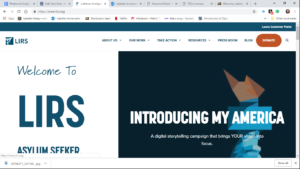
In a heating political climate in which “immigration” is now a household and sensitive topic, this website exists within the context that it is relevant to today’s current issues of immigration to the U.S. It even includes a newsletter that details these issues.
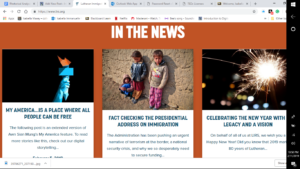
Several years ago, when the internet was recently invented, this website would not have existed because online media was incredibly new as well as an untouched frontier. In this present context, one can simply use a search engine to find a site like LIRS’s to learn more about the issue. The medium is online to provide this convenience, ease, and efficiency for both the LIRS and their audience. The social and cultural connotations of the text are that while immigration is a hot topic that demands attention in the media, it is also often seen as a threat to inhabitants of the U.S., depending on how the information is presented.
Beneath the “ABOUT US” tab of the navigation bar, there is a link to a page titled “OUR LEADERSHIP.” This page of the LIRS website gives the names of the Executive Committee of LIRS, At-Large Members, and Staff Leaders (Lutheran Immigration and Refugee Service, 2019).
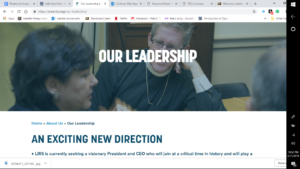
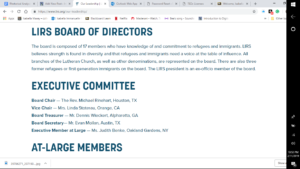
There are no direct names of the author(s) or creator(s) of the website, therefore one can assume that the names that comprise the lists of LIRS’ leadership page played key roles in the development of the website. In essence, the website is a portfolio of the work done by the LIRS, which is compiled by the different experiences and works accomplished by all members. Therefore, the author of the website is the organization as a whole.
The Lutheran Immigration and Refugee Service organization has successfully applied rhetoric to their multimodal website, www.lirs.org. They were able to communicate the need and desire for change to the public, and reach their audience based on the accounts of experiences from refugees, volunteers, and donors. They have made known their purpose of persuading the audience to give through the literal written text asking to give, as well as giving clear options to do so throughout the website. They have made known to their audience that they are of a nonprofit genre through the formatting of the website as well as the content of the text communicated. The context of the website also communicates the relevance of their message, motivating the audience as well as permitting them to take the required action now. While there was no clear name given, the author of the website can be concluded as the organization itself, glorifying its purpose rather than the faces behind it. These are all factors that have allowed LIRS to induce change through their website.
VIDEO ANALYSIS: https://drive.google.com/open?id=1aAoW1iJK3V3iBWZ2ylANBD41IxSo28ZU
Citation
“Lutheran Immigration and Refugee Service.” LIRS, 9 Feb. 2019, www.lirs.org/.